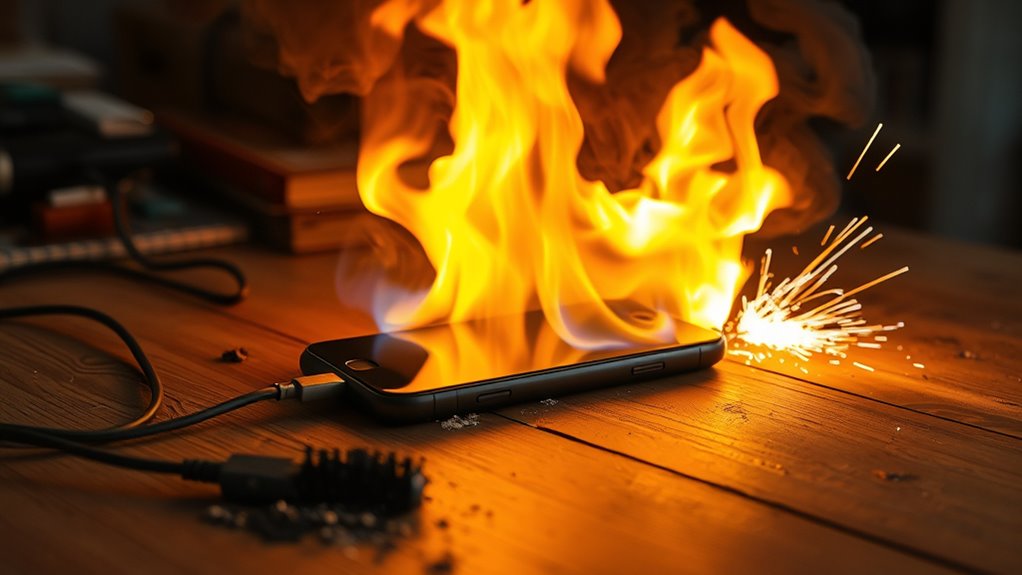To stay safe during home charging, always use manufacturer-approved chargers and avoid overcharging or unattended charging. Store batteries in cool, dry places away from heat, water, or metal objects. Watch for signs of damage like swelling, leaks, or overheating, and handle batteries carefully. Confirm good ventilation and follow safety guidelines to prevent fires. If you keep these tips in mind, you’ll better understand how to protect yourself and your home from lithium-ion battery hazards.
Key Takeaways
- Always use manufacturer-approved, certified chargers compatible with your device to prevent overcharging and unstable current supply.
- Charge batteries in cool, dry, well-ventilated areas away from heat sources and avoid unattended charging sessions.
- Regularly inspect chargers and batteries for damage, swelling, leaks, or corrosion, and replace any faulty components immediately.
- Disconnect devices once fully charged and avoid overcharging to prevent heat buildup and potential fires.
- Store batteries properly in protective cases, away from metal objects and moisture, to reduce short-circuit and fire risks at home.
Understanding Lithium-Ion Battery Chemistry and Risks
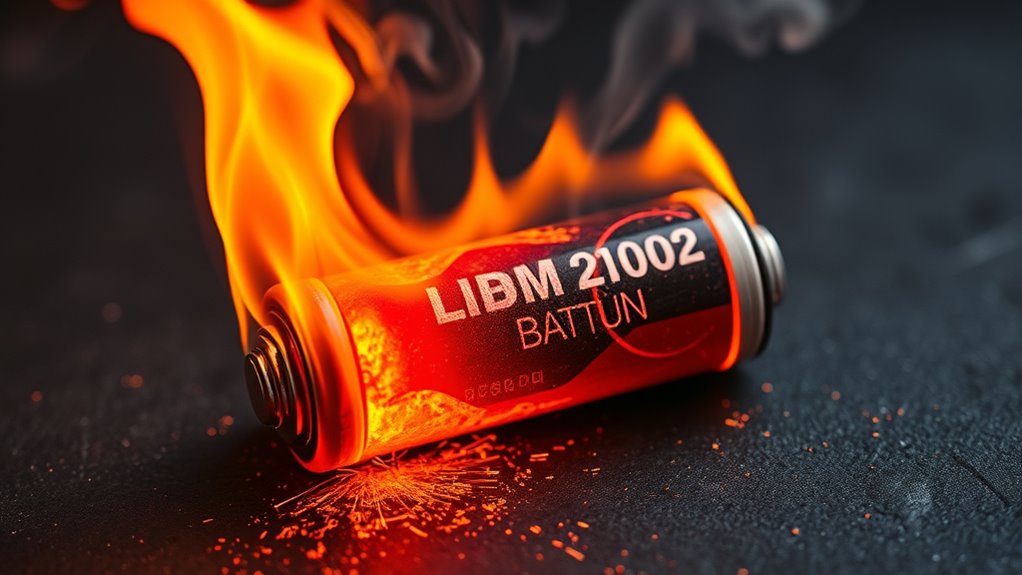
Lithium-ion batteries power many of your everyday devices, but understanding their chemistry is key to recognizing the risks they pose. These batteries contain a lithium-based electrolyte and layered materials like graphite and metal oxides that store and release energy through chemical reactions. When functioning properly, they provide a reliable power source. However, if damaged or improperly handled, these reactions can become unstable, leading to overheating or thermal runaway. This process occurs when the internal temperature rises uncontrollably, causing the battery to catch fire or explode. The volatile nature of lithium and the flammable electrolyte make these risks especially dangerous. Knowing how these batteries work helps you appreciate the importance of careful handling, proper charging, and avoiding damage that could trigger dangerous failures. Proper maintenance and understanding of air quality concerns can also help ensure safer usage of devices powered by these batteries.
Common Causes of Battery Fires During Charging
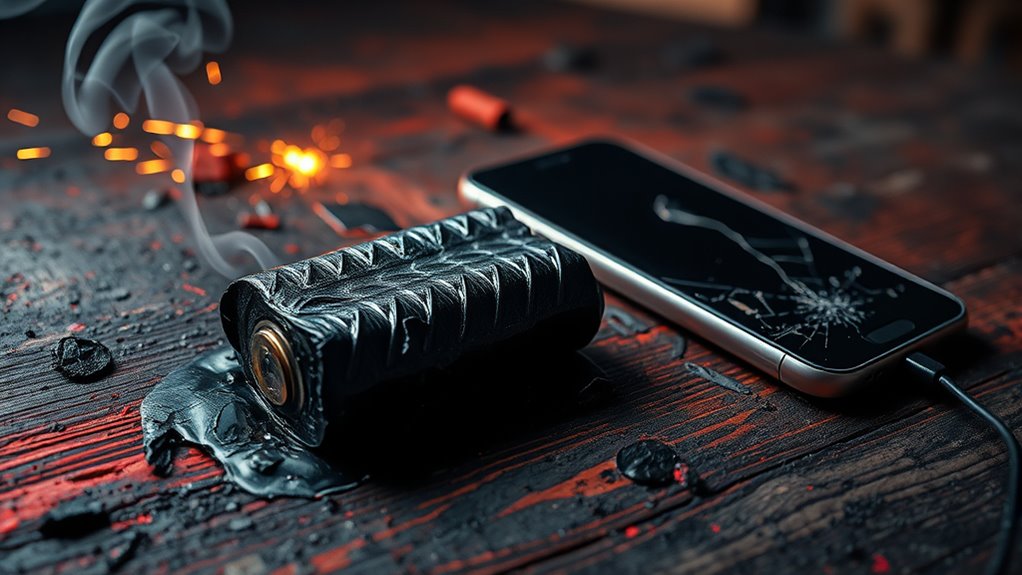
You might unknowingly put your device at risk if you overcharge the battery or use faulty charging equipment. Overcharging can cause excessive heat and pressure, leading to fires, while poor-quality chargers may deliver unstable power. Being mindful of these common issues can help prevent dangerous charging incidents. Additionally, using reliable safety measures during charging can further reduce the risk of battery fires.
Overcharging Risks
Overcharging a battery occurs when it remains connected to a power source beyond its full capacity, leading to dangerous conditions. When you overcharge, the battery can overheat, swell, or even catch fire. This happens because excess energy causes the internal components to break down, releasing flammable gases. To prevent this, use chargers with built-in overcharge protection. Recognizing the risks is vital for safety. Additionally, understanding AI in Education can help improve safety training methods for consumers.
Faulty Charging Devices
Have you ever wondered how faulty charging devices can cause battery fires? When a charger is damaged, poorly manufactured, or incompatible, it can supply inconsistent or excessive current to your battery. This overload stresses the lithium-ion cells, generating heat and increasing the risk of thermal runaway. Faulty chargers may also have exposed wiring or compromised insulation, leading to short circuits. Using unofficial or low-quality chargers amplifies these risks because they often lack proper safety features. Even a minor defect can cause sparks or overheating during charging. Always inspect your charger for damage, use original or certified options, and avoid cheap replacements. Properly functioning charging devices are essential to preventing fires and ensuring your battery charges safely. Understanding interest rates and the importance of quality in financial products is similar to recognizing the value of safe and reliable charging equipment for your batteries.
Recognizing Signs of Battery Damage or Malfunction
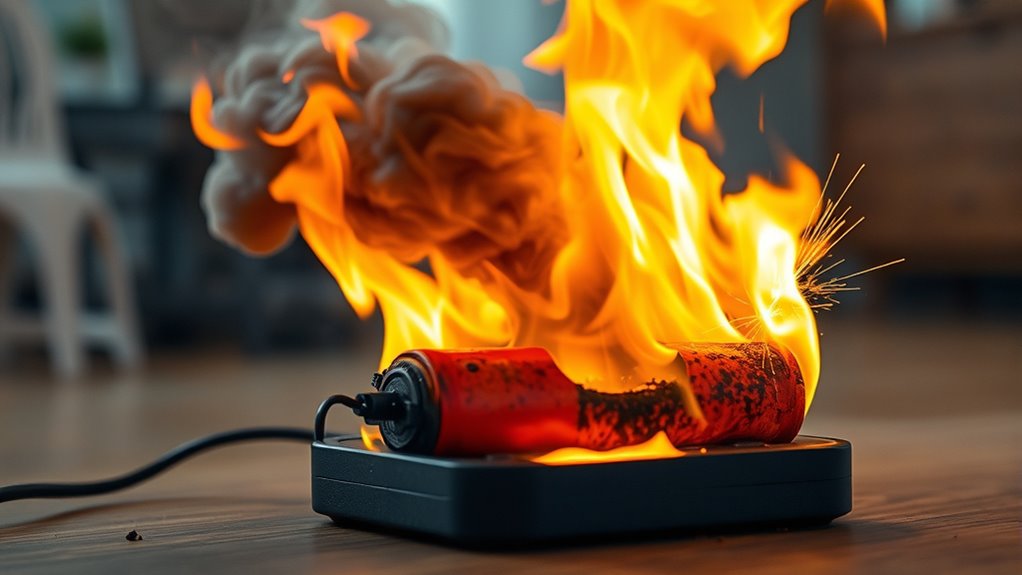
Recognizing signs of battery damage or malfunction is crucial for preventing potential fires. If your battery begins to swell, it’s a clear warning that something’s wrong. Any bulging or distortion indicates internal damage and requires immediate attention. Watch for leaks, corrosion, or a strange smell—these often signal chemical leaks or overheating. Discoloration or burn marks on the battery’s surface are serious red flags. Additionally, if your device suddenly loses power, won’t hold a charge, or heats up excessively during use or charging, stop using the battery right away. Unusual noises, such as hissing or popping sounds, also suggest internal failure. Regular maintenance and awareness of battery health monitoring can help identify issues early. By staying alert to these signs, you can act quickly and reduce the risk of fire or injury.
Proper Charging Equipment and Compatibility
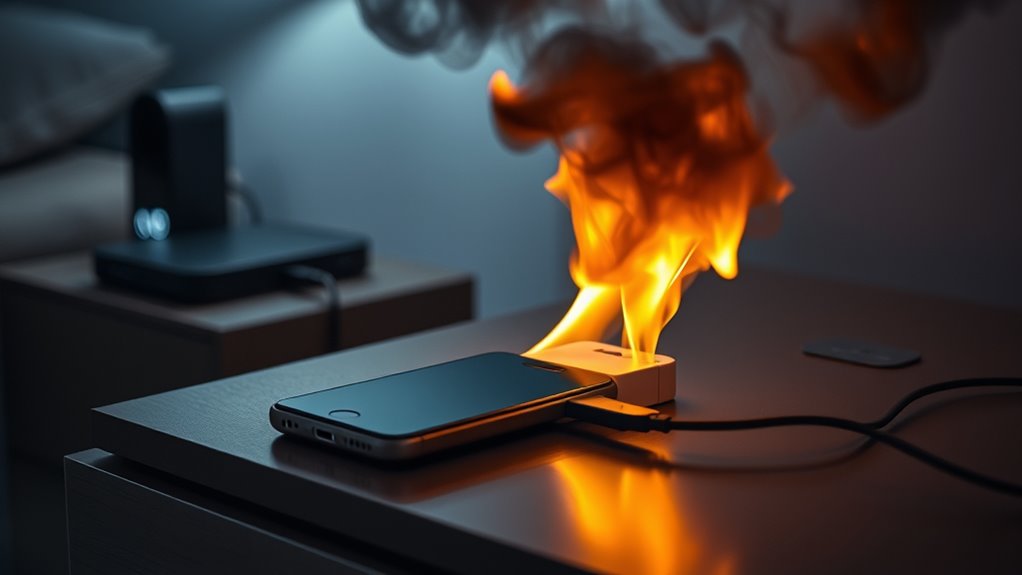
Using certified chargers guarantees your battery charges safely and efficiently. You should always match your charger to your battery’s specifications to prevent overcharging or damage. Avoid unauthorized adapters, as they can compromise safety and increase fire risk. Additionally, selecting top-rated products can ensure better compatibility and longevity for your battery.
Use Certified Chargers Only
To minimize the risk of lithium-ion battery fires, always choose certified chargers that are specifically designed for your device. Using uncertified or counterfeit chargers can lead to electrical faults, overheating, and potential fires. Certified chargers undergo safety testing to verify they meet industry standards, providing reliable voltage and current flow. Check for official labels or markings from reputable organizations like UL, CE, or FCC. Avoid using generic or off-brand chargers, especially if they don’t match your device’s specifications. Even if a charger looks similar, incompatible power outputs can damage your battery or cause dangerous overheating. Investing in the right, certified charger helps ensure safe, efficient charging and protects your device and home from fire hazards. Additionally, using chargers with proper Glycolic Acid compatibility can help prevent overheating issues in devices with sensitive components.
Match Battery Specifications
Ensuring your charging equipment matches your battery’s specifications is essential for safe and efficient operation. Using incompatible chargers can lead to overheating, fires, or damage to your battery. Always check the voltage, current, and connector type before plugging in. Match the charger’s output ratings to those specified by the manufacturer. Use the correct charger designed for your battery’s size and chemistry to prevent overcharging or undercharging. Additionally, verify that the charger is vetted for safety and approved for your specific battery type to minimize risks.
Avoid Unauthorized Adapters
Choosing the right charger is vital for maintaining battery safety and performance. Using unauthorized adapters can lead to improper voltage or current, risking overheating, fires, or battery damage. Always select chargers recommended by your device manufacturer or those that meet official safety standards. Check the specifications on the charger—voltage, current, and connector type—to guarantee compatibility with your device. Avoid cheap or counterfeit adapters, as they often lack proper safety features and quality control. Using incompatible or uncertified chargers can cause electrical surges or short circuits, increasing fire risk. Keep your device safe by sticking to authorized chargers designed for your battery. When in doubt, consult the device manual or manufacturer’s guidelines before trying a new adapter. Proper charger compatibility is key to safe, efficient charging.
Optimal Charging Practices for Safety
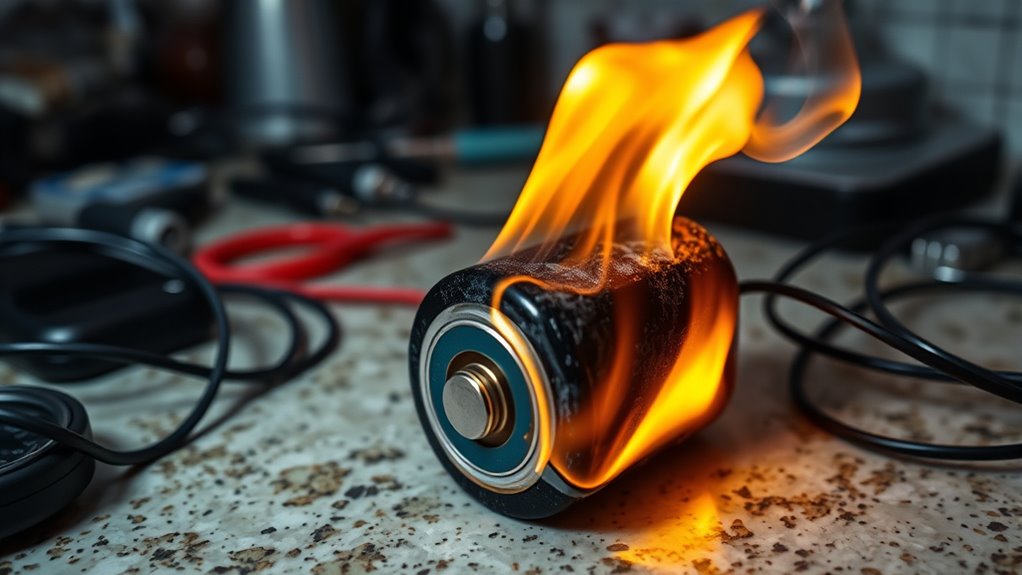
Following proper charging practices is essential for maintaining safety and preventing lithium-ion battery fires. By following these steps, you reduce the risk of dangerous incidents in your home:
Proper charging habits prevent lithium-ion fires and keep your home safe.
- Use the right charger—always choose the manufacturer-approved charger to prevent overheating and damage.
- Avoid overcharging—disconnect your device once it’s fully charged to prevent stress on the battery.
- Charge in a cool, dry place—keep your device away from heat sources and moisture that can cause malfunctions.
- Don’t leave charging devices unattended—stay nearby to catch any signs of trouble early, like swelling or excessive heat.
Taking these precautions keeps your home safe and your devices reliable, giving you peace of mind every day.
Safe Storage and Handling of Batteries
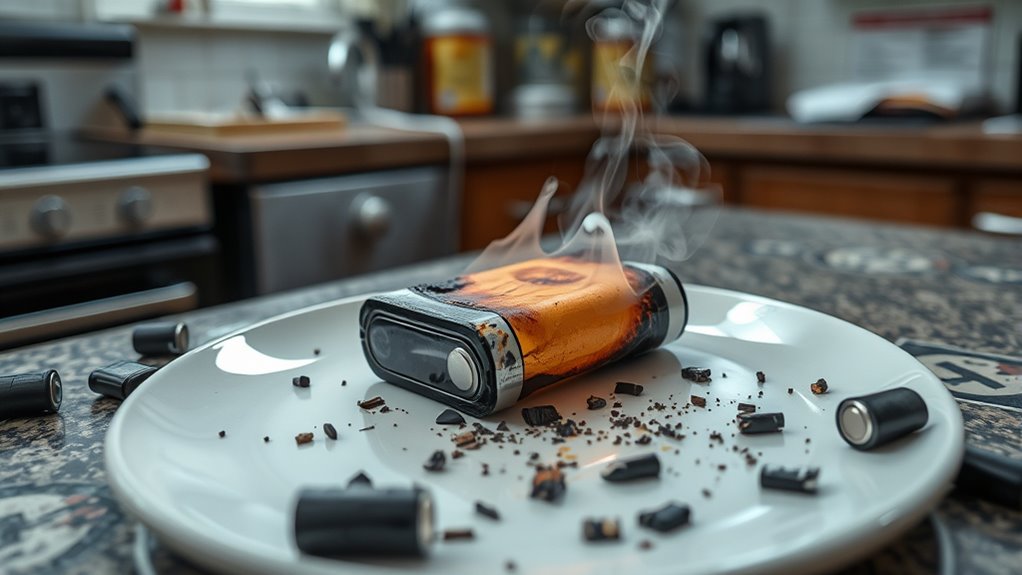
Properly storing and handling lithium-ion batteries is essential for preventing fires and accidents. Always keep batteries in a cool, dry place away from direct sunlight and heat sources. Avoid puncturing, crushing, or exposing batteries to water. Use original packaging or protective cases to prevent damage during transport or storage. Handle batteries with care, avoiding dropping or applying excessive pressure. Store batteries separately from metal objects like keys or coins to prevent short circuits. Additionally, following inspirational quotes about fatherhood can remind us of the importance of care and responsibility in handling sensitive items like batteries.
The Role of Ventilation and Environment in Fire Prevention
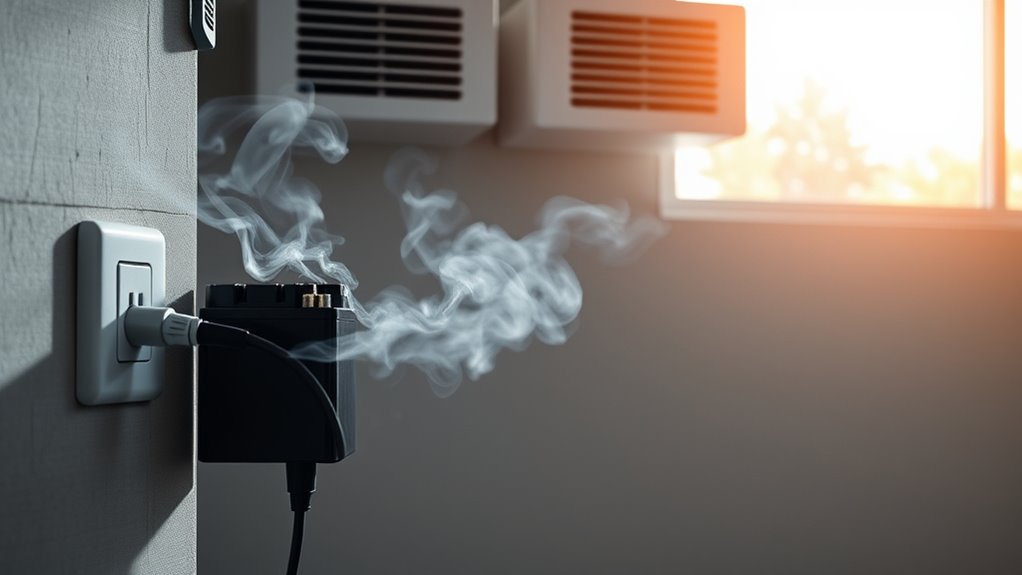
Good ventilation and a suitable environment are crucial for preventing lithium-ion battery fires. Proper airflow helps disperse heat, reducing the risk of thermal runaway. A safe environment keeps batteries cool and minimizes exposure to flammable materials. To protect yourself and your home, consider these essential steps:
Proper ventilation and a safe environment are key to preventing lithium-ion battery fires.
- Keep batteries in well-ventilated areas to prevent heat buildup.
- Avoid storing batteries near heat sources or direct sunlight.
- Maintain a cool, dry environment to reduce chemical reactions.
- Ensure there’s enough space around batteries for airflow and inspection.
Neglecting ventilation can turn a small fault into a dangerous fire. Your vigilance in creating a safe environment drastically lowers the chance of a catastrophic event. Stay alert, stay safe.
Emergency Response Steps if a Battery Fires
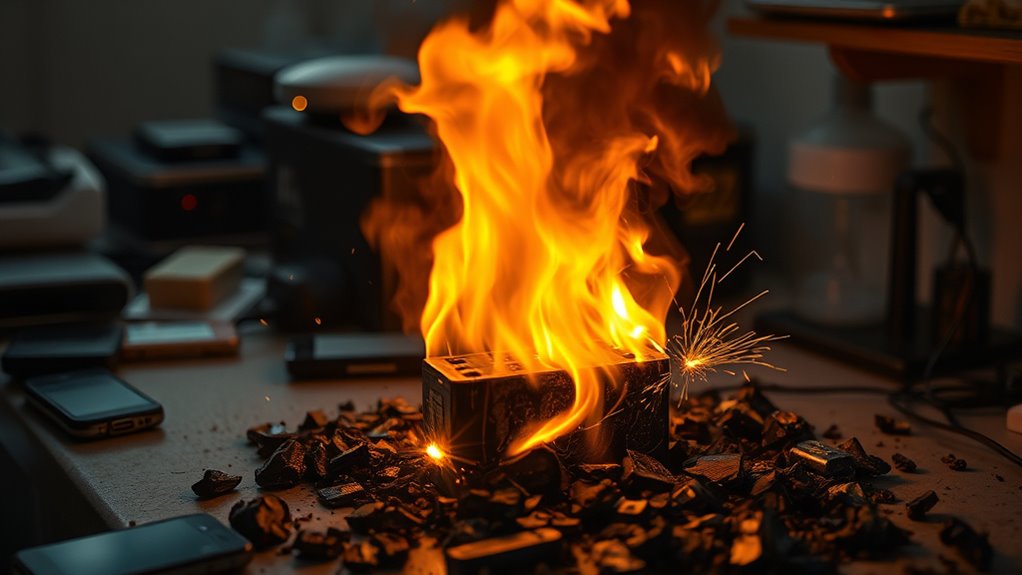
When a lithium-ion battery catches fire, quick and informed action can prevent injuries and limit property damage. First, evacuate everyone from the area and call emergency services immediately. Do not attempt to extinguish the fire with water, as this can make it worse. Instead, use a Class D fire extinguisher if available, or smother the flames with a fire-resistant blanket or sand. If a fire extinguisher is used, aim at the base of the flames and stay a safe distance away. Keep in mind that battery fires can produce toxic fumes, so ensure proper ventilation if possible. After the fire is out, dispose of the damaged battery properly according to local regulations, and avoid re-ignition risks.
Tips for Selecting Safe Charging Devices and Accessories
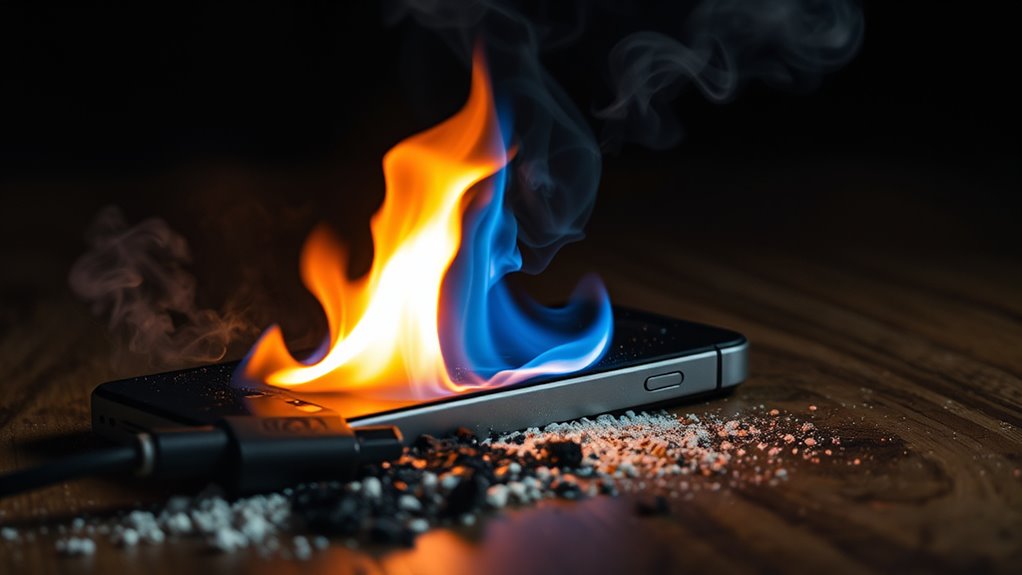
Choosing the right charging devices and accessories is essential to prevent lithium-ion battery fires. Using cheap or incompatible chargers can lead to overheating, fires, or explosions. To stay safe, follow these tips:
- Use original or certified chargers that meet safety standards—avoid knockoffs or unverified brands.
- Check for compatibility with your device before plugging in—mismatched chargers can cause damage or fire hazards.
- Avoid damaged cables or connectors—frayed or broken accessories increase risk.
- Don’t overcharge or leave devices charging unattended—monitor the process to prevent overheating.
Frequently Asked Questions
Can Lithium-Ion Batteries Explode During Home Charging?
You might wonder if lithium-ion batteries can explode while charging at home. Yes, they can, but it’s rare when you follow safety guidelines. Overcharging, using damaged batteries, or faulty chargers increase the risk. Always use the manufacturer’s charger, avoid exposing batteries to extreme heat, and never leave them charging unattended. Proper handling and safety precautions considerably reduce the chance of a dangerous explosion during home charging.
How Often Should I Replace Aging or Damaged Batteries?
Think of your battery like a ticking time bomb—you don’t want to wait until it’s too late. You should replace aging or damaged batteries immediately to prevent hazards. Regularly inspect for swelling, leaks, or corrosion, and follow manufacturer guidelines for lifespan. If your battery shows signs of wear or damage, don’t hesitate to replace it promptly. Staying proactive keeps you safe and your devices running smoothly.
Are There Specific Brands With Higher Safety Standards?
You wonder if some brands have higher safety standards. While no brand is completely risk-free, reputable companies like Samsung, LG, and Panasonic generally follow strict safety protocols and quality controls. Always check for certifications like UL or CE and read reviews before purchasing. Keep your batteries maintained and avoid third-party chargers to minimize risks. By choosing trusted brands and practicing safe charging habits, you can better protect yourself from potential hazards.
What Are the Legal Regulations for Home Battery Storage?
Like a guardian watching over your energy, legal regulations set the boundaries for home battery storage. You need to follow local building codes, safety standards, and electrical regulations, which vary by region. Permits and inspections guarantee safe installation, preventing hazards like fires. Staying informed about evolving regulations helps you protect your home and loved ones, ensuring your energy future remains secure within the framework of law and safety.
How Do I Dispose of a Lithium-Ion Battery Safely?
To dispose of a lithium-ion battery safely, you should first avoid throwing it in regular trash. Instead, take it to a designated recycling center or an authorized battery disposal facility. Beforehand, drain the battery if possible and cover the terminals with non-conductive tape to prevent sparks. Always handle batteries carefully to avoid punctures or damage, and follow local regulations to guarantee safe and environmentally friendly disposal.
Conclusion
Think of your lithium-ion batteries as tiny fires waiting to ignite. When you follow proper charging practices—using the right equipment, keeping an eye on signs of damage—you act as the firefighter, preventing disaster. I once saw a friend catch a small spark from a neglected battery, and it reminded me how quickly things can escalate. Stay vigilant, handle batteries with care, and you’ll keep your home safe, turning potential fires into stories of safety and awareness.
